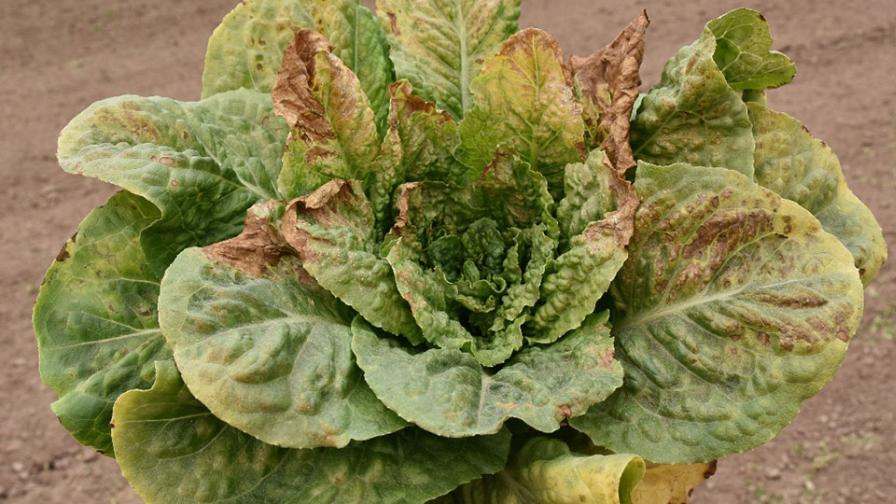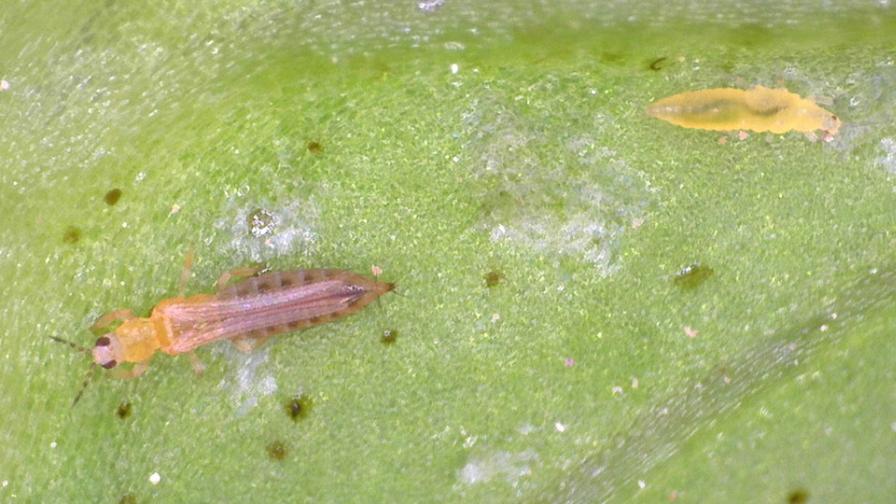Rethinking Thrips Management in Desert Lettuce

This romaine lettuce plant is infected with Impatiens Necrotic Spot Virus (INSV). Don’t hesitate to test the leaves, since these symptoms look a lot like chemical burn.
Photo by John Palumbo
Managing Western Flower thrips, Franklienella occidentalis, in desert lettuce traditionally focuses on preventing feeding damage. Left unchecked, this cosmetic scarring can downgrade quality or even render the crop unmarketable. All it takes to prevent damage is two to three well-timed insecticide applications.
However, discovering Impatiens Necrotic Spot Virus (INSV) in desert lettuce last spring changed attitudes. The Yuma outbreak followed two successive seasons of significant INSV outbreaks in Salinas, CA. Growers now need to manage thrips with the intent of preventing INSV infection.
How Infection Happens
It’s important to understand how western flower thrips acquire and transmit the virus.
First, primary infection or spread occurs when INSV-infected adults from an outside host source migrate into lettuce fields, feed, and transmit INSV to otherwise healthy plants. An adult thrips can only transmit the virus; it cannot acquire the virus from an infected plant.
Secondary infection or spread occurs when thrips larvae acquire INSV by feeding on an infected plant (either lettuce or nearby weeds), complete development, and emerge as infected adults capable of transmitting INSV throughout the field or nearby lettuce fields.
Remember, only adults transmit INSV, whereas only larvae acquire the virus from feeding on an infected plant. It is an unusual pathosystem.
Management Tips
Until we have a better understanding of INSV on desert lettuce, we recommend growers adjust their thrips management programs, particularly in high-risk areas.
Season-Long Sanitation Is Critical — Maintaining a clean cropping system via cultural management is foundational. It eliminates sources of the virus and the vector. Because several weed species commonly found in the desert (e.g., cheeseweed and nettleleaf goosefoot) serve as reservoirs for both thrips and INSV, thorough weed control in and around produce fields will help reduce INSV and thrips. Additionally, following harvest, growers should disc crop residue as quickly as possible.
Scouting Is Important — Research shows visually examining thrips on lettuce leaves often underestimates the actual numbers due to their small size and cryptic nature. If you find a few adults and larvae on a plant, there are likely several-fold more thrips on the plant.
Focus on Minimizing Secondary Spread — It’s difficult to prevent primary infection from the outside, but minimizing larvae populations should help suppress a secondary spread.
Adjust Spray Timing in High-Risk Areas — Preventatively treat lettuce fields with effective insecticides early and aggressively in areas considered high risk for INSV infection.
• Treat lettuce transplants originating from Salinas just before or shortly after transplanting.
• Treat direct-seeded lettuce fields grown adjacent to or near fields with lettuce transplants early and aggressively when thrips first appear.
• Closely monitor areas where you found significant INSV last year, and treat it preventatively when thrips appear.
Using Insecticides Differently — Consider incorporating methomyl with chemical thinners and smart sprayers.
• Consider tank-mixing methomyl or Torac (Nichino America, Inc.) with insecticides targeting beet armyworm, cabbage looper, and whiteflies if thrips are present in the field.
• Consider rotating Minecto Pro (Syngenta) or Exirel (FMC) with Radiant (Corteva) for beet armyworm and cabbage looper control. Similarly, when targeting aphids, consider rotating Beleaf (FMC) or acephate with Movento (Bayer Crop Science). All these products have shown to control or provide suppression of western flower thrips larvae.
• Consider tightening spray intervals when thrips pressure increases, or when the first signs of INSV occurs in the immediate area.
Test Symptomatic Plants Immediately — The earlier you discover INSV in a field, the better chance of reducing secondary spread. INSV symptoms in lettuce can be confused with chemical spotting or necrosis resulting from pesticide sprays or leaks from hydrolic/fertilizer hoses. So don’t hesitate to have plants tested for INSV. Several university and private laboratories can quickly confirm the presence of INSV in symptomatic leaves, and growers can use immunostrip kits in the field to accurately detect INSV in plant tissue.
How Did INVS Arrive in the Desert?
This has led us to questions about the virus and its epidemiology in desert cropping systems relative to last season. Perhaps the most pressing question is why INSV suddenly appeared last March when it had never been never detected in desert lettuce before. Anecdotally, it has been presumed that INSV arrived on infected lettuce transplants, or infected adults hitching a ride on transplants, or equipment arriving from Salinas.
Given that growers in California battled INSV all last season, and coastal nurseries produce most of the lettuce transplants grown in the desert, we assumed that INSV would arrive in the desert at some point this season. We assumed correctly. INSV were discovered in Yuma, AZ in October 2021 on romaine transplants.











